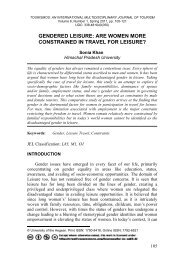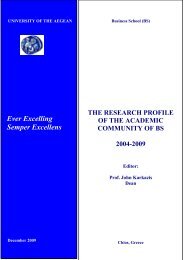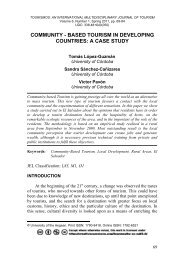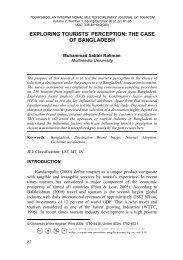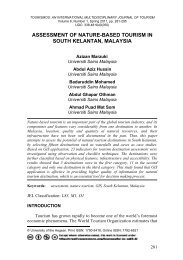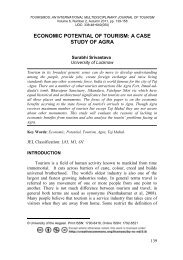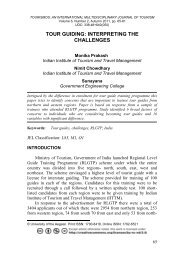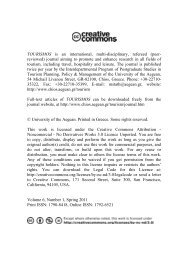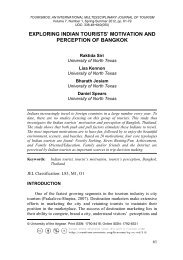COMMONS DEED
COMMONS DEED
COMMONS DEED
Create successful ePaper yourself
Turn your PDF publications into a flip-book with our unique Google optimized e-Paper software.
TOURISMOS: AN INTERNATIONAL MULTIDISCIPLINARY JOURNAL OF TOURISM<br />
Volume 6, Number 3, Winter 2011, pp. 13-36<br />
UDC: 338.48+640(050)<br />
industry expertise (Krishnan 2003). It is also documented that Big 4<br />
auditors are more conservative because they have to protect their brand<br />
name (DeAngelo 1981a, 1981b; Krishnan 2003).<br />
Spanish hotel industry is characterized by non-audited firms due to<br />
the small firms-dimension. The control of the financial information for<br />
non-audited is not so strict in relation to other firms. This makes easier to<br />
alter the financial information.<br />
DESING OF THE EMPIRICAL RESEARCH<br />
This paper focuses on earnings benchmarks in Spanish hotel industry.<br />
We use SABI database (Iberian Balance Sheet Analysis System database)<br />
to collect financial information about Spanish hotel industry. We obtain<br />
9,950 observations from 1999 to 2003.<br />
First, we investigate the hypothesis of avoiding losses and earnings<br />
decreases. To do that, we focus on net income and changes in net income.<br />
The methodology used as a proxy to earnings benchmarks is frequency<br />
histograms. Burgstahler & Dichev (1997) find a discontinuity around the<br />
zero point in the distribution of earnings (levels and changes). They<br />
observe a statistically small number of firms with small losses and a<br />
statistically large number of firms with small profits. This evidence was<br />
interpreted as management strategy to meet earnings benchmarks. Under<br />
non-earnings management hypothesis, a smooth distribution of earnings<br />
around the zero point is expected.<br />
We expect that the discontinuity at zero is more pronounced when the<br />
incentives to incur in earnings management increases. To build frequency<br />
histograms, we use the formula of Degeorge et al. (1999) to compute the<br />
frequency of observations in each partition of the histogram: 2(q3-q1)/ N-<br />
1/3, where q3 is the third quartile, q1 is the first quartile and N is the<br />
sample number. This formula is one of the most used in the empirical<br />
research on earnings benchmarks. The deflators of earnings are assets at<br />
the beginning of the year.<br />
Second, as focusing on a particular industry with specific<br />
characteristics, we choose a possible key incentive to engage in earnings<br />
management. The access to debt-bank in the expansion process taken by<br />
Spanish hotel industry is an important issue. Then, we analyze the<br />
incidence of leverage as proxy to debt covenants in our two earnings<br />
benchmarks. To conduct our analysis, we split the sample according to<br />
the level of leverage and we examine the discontinuity in frequency<br />
histograms at zero point. We predict that high leverage firms could have<br />
19



